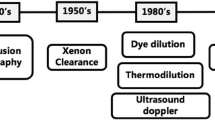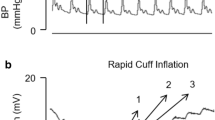Summary
Because of the lack of non-invasive methods for measuring muscle blood flow, quantitative investigations of blood flow in the skeletal muscle of hypertensive subjects are rare. We therefore developed a new method for the determination of muscle blood flow noninvasively and quantitatively by a combination of computed tomography and venous occlusion plethysmography (strain-gauge method).
At two sites on one forearm (p=site of the largest diameter, d=1 cm proximal to the epicondyle lat.) the volumes of tissues [Vt=total volume, VM=muscle volume, Vsk=bone volume, VR=residual volume=Vt−(VM+VSk)] were determined by computed tomograms and total forearm blood flow (Fp and Fd, respectively in ml/100 ml tissue x min) measured by strain-gauge plethysmography. After correcting for the bone volume at the different sites, Fp and Fd were transformed into the absolute influx rates of blood volume (Qp and Qd). From Qp and Qd and the different tissue volumes, the muscle bloof flow (FM in ml/100 ml muscle x min) could be calculated:
Results thus derived were compared with data from the literature Cooper et al. (17). At rest there was neither a significant difference in Fp (own results: 3.62±1.67, Cooper: 3.25±1.42 ml/100 ml tissue x min, means±S.D.) nor in FM (4.08±2.07 and 3.66±1.57 ml/100 ml muscle x min, respectively), however, Fp and FM were significantly different (p<0.05). In the mean, FM was 13% greater than Fp, range: −40 to +38% (Cooper 15%, range: −17 to +43%). The individual difference could not be predicted by any of the parameters.
Testing the procedure by means of a pharmacological agent (clonidine) with known effects on muscle blood flow (no change) and skin blood flow (decrease) revealed the correct reproduction of this hemodynamic pattern with our method. The usual identification of total with muscle blood flow would have led to false conclusions.
Similar content being viewed by others
References
Abramson DI (1967) Circulation in the extremities. Academic Press, New York London
Abramson DI, Ferris Jr EB (1940) Responses of blood vessels in the resting hand and forearm to various stimuli. Am Heart J 19:541–543
Baaron JN, Veall N, Arnott DG (1951) The measurement of the local clearance of radioactive sodium in tubed skin pedicles. Br J Plastic Surg 4:16–27
Barbey K, Barbey P (1963) Ein neuer Plethysmograph zur Messung der Extremitätendurchblutung. Z Kreisl Forsch 52:1129–1140
Barbolini G, Tischendorf F, Curri SB (1971) Histology, histochemistry and function of the human digital arteriovenous anastomoses (Hoyer Grosser's organs, Masson's glomera). Microvas Res 2:142–153
Barcroft H, Bonnar WMck, Edholm OG, Effron AS (1943) On sympathetic vascoconstrictor tone in human skeletal muscle. J Physiol 102:21–31
Becker HM, Klemm J (1972) Zur Wertigkeit der Dehnungsmeßstreifen-Stauplethysmographie. Herz/Kreisl 4:254–258
Bell C, Harper AM (1964) Measurement of regional blood flow through the skin from the clearance of Krypton-85. Nature 202:704–705
Braithwaite F, Farmer FT, Herbert FI (1951) Observations on the vascular channels of tubed pedicles using radioactive sodium: III. Br J Plast Surg 4:38–47
Brodie TG, Russell AE (1905) On the determination of the rate of blood flow through an organ. J Physiol 32:47–49
Buchanan TJ, Walls EW, Williams ES (1954) Studies in radiosodium clearance from the skin in man, Clin Sci 13:333–343
Burton AC (1953) Peripheral circulation. Ann Rev Physiol 15:213–246
Clark ER (1938) Arterio-venous anastomoses. Physiol Rev 18:229–247
Clarke RSJ, Ginsburg J, Hellon RF (1958) Use of the strain-gauge plethysmograph in assessing the effect of certain drugs on the blood flow through the skin and muscle of the human forearm. J Physiol 140:318–326
Clarke RSJ, Hellon RF (1957) Venous collection in forearm and hand measured by the strain-gauge and volume plethysmograph. Clin Sci 16:103–117
Cooper KE, Edholm OG, Fletcher JG, Fox RH, MacPherson RK (1954) Vasodilation in the forearm during indirect heating. J Physiol 125:56–57P
Cooper KE, Edholm OG, Mottram RF (1955) The blood flow in skin and muscle of the human forearm, J Physiol 128:258–268
Donald DE, Shepherd JT (1978) Reflexes from the heart and lungs; physiological curiosities or important regulatory mechanisms. Cardiovasc Res 12:449–469
Edholm OG, Howarth S, McMichael J (1945) Studies on the peripheral circulation in osteitis deformans. Clin Sci 5:249–260
Graf K (1964) Auswertung und Meßfehler okklusions-plethysmographischer Durchblutungsregistrierung. Acta Physiol Scand 60:120–135
Grant RI, Bland EF (1931) Observations on arteriovenous anastomoses in human skin and in the bird's foot with special reference to the reaction to cold. Heart 15:385–407
Grant RT, Pearson RSB (1938) The blood circulation in the human limb; observations on the differences between the proximal and distal parts and remarks on the regulation of body temperature. Clin Sci 3:119–139
Greenfield ADM, Whitney RJ, Mowbray JF (1963) Methods for the investigation of peripheral blood flow. Brit Med Bull 19:101–109
Gutmann J, Kachel V, Bründl G (1969) Vergleichende Messungen mit neuen rheographischen und plethysmographischen Durchblutungsmeßgeräten. Elektromed Sonderheft 87
Harries R, Martin AJ, Williams HS (1952) Correlation of the skin temperature and circulatory changes in muscle and subcutaneous tissue of the hand during trunk heating. Clin Sci 11:429–440
Hellon RF, Clarke RSJ (1959) Changes in forearm blood flow with age. Clin Sci 18:1–7
Hensel H (1951) Ein Strömungscalorimeter für beliebige Körperstellen. Z ges exp Med 117:587–597
Hensel H (1952) Ein neues Verfahren zur peripheren Durchblutungsregistrierung an beliebigen Körperstellen. Z Kreisl Forsch 41:251–261
Hensel H, Bender F (1956) Fortlaufende Bestimmung der Hautdurchblutung am Menschen mit einem elektrischen Wärmelcitmesser. Arch ges Physiol 263:603–614
Hensel H, Bock KD (1955) Durchblutung und Wärmeleitfähigkeit des menschlichen Muskels. Pflüg Arch ges Physiol 260:361–367
Hensel H, Ruef J (1954) Fortlaufende Registrierung der Muskeldurchblutung am Menschen mit einer Calorimetersonde. Arch ges Physiol 259:267–280
Hensel H, Ruef J, Golenhofen K (1955) Human muscle and skin blood flow: The effect of vasoactive substances. Angiology 6:190–207
Hewlett AW, van Zwaluwenburg JG (1909) The rate of blood flow in the arm. Heart 1:87–97
Holling HE, Boland HC, Russ E (1961) Investigation of arterial obstruction using a mercury-inrubber strain-gauge. Am Heart J 62:194–205
Hyman C, Winsor T (1960) The application of the segmental plethysmography to the measurement of blood flow through the limbs of human beings. Am J Cardiol 6:667–671
Hyman C, Greeson T, Clem M, Winsor D (1964) Capacitance-plethysmograph method for separating blood flow in muscle and skin in the human forearm. Am Heart J 68:508–514
Jones EL, Wagner Jr HN, Zuidema GD (1965) New method for studying peripheral circulation in man. Arch Surg 91:725–737
Kerslake DM (1949) The effect of the application of an arterial occlusion cuff to the wrist on the blood flow in the human forearm. J Physiol Lond 108:451–457
Kety SS (1949) Measurement of regional circulation by the local clearance of radioactive sodium. Am Heart J 38:321–328
Lassen NA (1964) Muscle blood flow in normal man and in patients with intermittent claudication evaluated by simultancous Xe-133 and Na-24 clearances. J Clin Invest 43:1805–1812
Lassen NA, Lindbjirg J, Munck O (1964) Measurement of blood-flow through skeletal muscle by intramuscular injection of Xenon-133. Lancet I:686–689
Merguet P, Bock KD (1973) Effects of antihypertensive agents on skin and muscle blood flow in man. In: Onesti G, Kim KE, Moyer JH (eds) Hypertension, Mechanisms and Management, Grune and Stratton, New York, pp 241–250
Mescon H, Hurley HJ, Moretti G (1956) Anatomy and histochemistry of the arteriovenous anastomoses in digital skin. J Invest Dermatol 27:133–143
Mörl H (1986) Physiologie der Hautdurchblutung — Methodische Nachweisverfahren. Herz Gefäße 6:145–152
Morton DJ, Truex RC, Kellner CE (1941) Manual of human cross section anatomy. Williams and Wilkins, Baltimore
Mottram RF (1955) The oxygen consumption of human skeletal muscle in vivo. J Physiol Lond 128:268–276
Niclsen SL, Bitsch V, Larsen OA, Lassen NA, Quaade F (1968) Blood flow through human adipose tissue during lipolysis. Scand J Clin Lab Invest 22:124–130
Popoff NW (1934) The digital vascular system. AMA Arch Pathol 18:295–330
Roddie IC (1983) Circulation of skin and adipose tissue. In: Shepherd JT, Abboud FM (eds) Handbook of Physiology, Sect 2, Vol III, Pt 1. Am Physiol Soc, Bethesda, pp 285–317
Roddie IC, Shepherd JT (1956) The blood flow through the hand during local heating, release of sympathetic vasomotor tone by indirect heating, and a combination of both. J Physiol Lond 131:657–664
Sejrsen P (1969) Blood flow in cutaneous tissue in man studied by washout of radioactive Xe. Circ Res 25:215–230
Sejrsen P (1967) Diffusion processes invalidating the intra-arterial Krypton-85 beta-particle clearance method for measurement of skin blood flow in man. Circ Res 21:281–295
Shaw NE (1964) Observations on the physiology of the circulation in bones. Ann R Coll Surg Engl 35:214–233
Shepherd JT (1985) Circulation to skeletal muscle. In: Shepherd JT, Abboud FM (eds) Handbook of Physiology, Sect 2, Vol III, Pt 1. Am Physiol Soc, Bethesda, pp 319–370
Smith BC, Quimby EH (1945) Use of radioactive sodium as tracer in study of peripheral vascular diseases. Radiology 45:335
Smith RE, Morales MF (1944) On the theory of blood-tissue exchanges. III. Applications. Bull Math Biophys 6:133–139
Wagner Jr HN, Jones EL, Tow DE, Langan JK (1965) A method for the study of the peripheral circulation in man. J Nucl Med 6:150–154
Walder DN (1955) The relationship between blood flow, capillary surface area and sodium clearance in muscle. Clin Sci 14:303–313
Weber F, Anlauf M (1982) Direkte und indirekte Vergleichsuntersuchungen zur Meßgenauigkeit des elektronischen Blutdruckmeßgerätes Tonomed®. Herz Kreisl 5:279–283
Whitney RJ (1954) The electrical strain-gauge method for measurement of peripheral circulation in man. In: Wolstenholme GEW, Freeman JS (eds) Peripheral Circulation in Man. Churchill, London, pp 45–52
Whitney RJ (1953) The measurement of volume changes in human limbs. J Physiol Lond 121:1–27
Author information
Authors and Affiliations
Additional information
Dedicated to Prof. Dr. K. D. Bock for his 65th birthday
Rights and permissions
About this article
Cite this article
Weber, F., Anlauf, M. & Serdarevic, M. Noninvasive, quantitative determination of muscle blood flow in man by a combination of venous-occlusion plethysmography and computed tomography. Basic Res Cardiol 83, 327–341 (1988). https://doi.org/10.1007/BF01907366
Received:
Issue Date:
DOI: https://doi.org/10.1007/BF01907366




